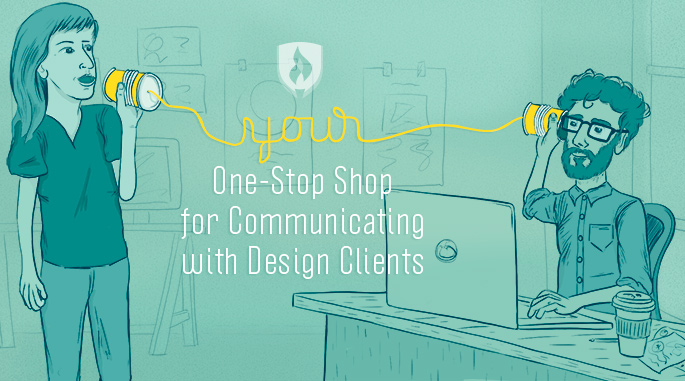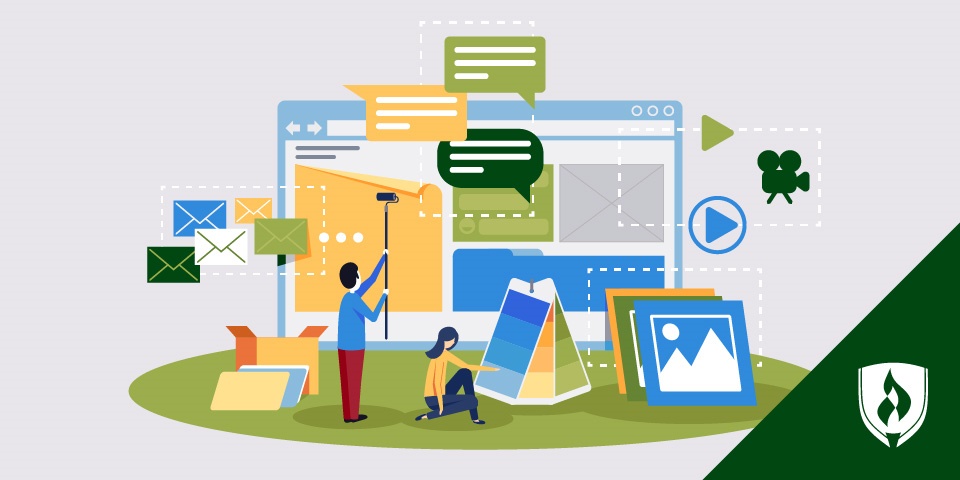
It’s no secret that design clients come with all sorts of over-the-top expectations about what you will create for them. After all, they hired you and promised to pay a (hopefully) substantial sum of money knowing you’ve got plenty of talent.
So what happens when expectations, presumptions and a variety of confusing miscommunications start worming their way into an otherwise well-established business relationship?
When it comes to freelance designers and their clients, communication is not only helpful—it’s absolutely essential for establishing and maintaining a successful working relationship. But impeccable communication skills aren’t formed overnight.
Whether you’re currently struggling with communicating with design clients or you’re looking for tips to help you dodge that bullet altogether, we’re here to help. We asked seasoned designers to share their best advice for handling client communication (and miscommunication), expectations, deadlines and more.
Keep reading for tips on how to improve your freelance design communication process.
7 Expert tips for communicating with design clients
1. Identify your client’s goals & expectations
This is, perhaps, the single most important thing to remember about being a freelance graphic designer. Without a clear vision of what your client’s expectations are for the project, how will you know if you’re properly meeting their needs?
“Do more listening than talking and learn to ask key questions,” advises creative director Beverly Solomon. “Make certain that you have a clear idea of what the client expects from you.”
This means talking through deadlines, drafts, editing and even expectations about payment and timelines. By understanding a client’s goals and objectives, you can cut down on revisions by grounding your design in a solid foundation of understanding.
2. Create a contract
“Over the years I've learned that a good contract can save me from a lot of headaches down the road,” says Stella Demetriou, co-founder and web designer at Chocolate and Caviar. She explains that your contract doesn’t have to be flooded with legal speech, but it should plainly outline the scope of the project, include a timetable with milestones and deadlines and contain a clear description of payment expectations.
If you’re concerned that you’re not equipped to create a real contract and employ it, never fear! There are plenty of online resources that will help guide you on your merry way. Check out Smashing Magazine’s Collective Legal Guide for Designers, browse through contract templates or read about the must-have contract clauses for your client agreement. A quick search of “contracts for freelance designers” online will provide you with a whole slew of helpful information to get you started.
3. Use client-friendly language
“Dumb it down—clients are not designers,” says Kevin O’Keefe, creative director at SmartFile. “Not everyone has the same eye for design that you do, so communication about design decisions and art direction can be frustrating.”
Design clients often don’t know exactly what they want in a design. They may have a general idea, but it’s typically a lot easier for a client to look at a draft and point out what they don’t want. Unless the client is seasoned in the area of design, this is where you can shine bright and strut your stuff.
Communicating about options, colors, samples, fonts and more can bring a lot more clarity to an otherwise fuzzy design vision. Showcasing your passion and knowledge of design will also help the client realize they’re in good hands and can trust your judgment.
4. Map out all deadlines upfront
Designers have a love/hate relationship with deadlines, but they’re a reality of the profession. Perhaps it’s in your creative nature to shun the dastardly term and, instead, enjoy flying by the seat of your pants. At the expense of popping your laid-back bubble, please note miscommunication often stems from a lack of discussion about deadlines.
If your client assumes that the type of design you’re doing should only take a few days, there may be some unkind words uttered when you send in your first draft three weeks later. Ask your client upfront when they expect a final product and be honest about what a realistic timeline looks like. Solomon advises designers to build in time for feedback and revisions in the timeline and understand who enforces it and keeps everyone on track.
5. Clarify who’s in charge
“Ask for one point-of-contact as soon as the project begins - just one!” advises Dmitri Logounov, head designer and founder of New Design Group. He adds that it’s critical to ensure you understand that particular person’s view of project parameters, budget, timing and objectives.
Important details can get muddled or lost in translation with too many voices involved. Having a single contact person will eliminate any unnecessary confusion about who said what to whom.
6. Pick up the phone & call
Perhaps it’s generational, but for some people, the phone can seem like a frightful option for communication.
“This seems simple, but we’re in the age of texting, tweeting and massive email exchange,” O’Keefe says. “As a designer, if you have questions that need answered immediately, you should consider calling the client.”
Questions are bound to surface during the design process, and days or even hours for a client’s email response isn’t conducive for keeping a project on track. Speed things up by picking up the phone and clear up all of your confusion in one quick conversation.
7. Remember, your client is a real human
When you work with all things digital, it’s easy to forget that you’re dealing with real people on the other side of the computer screen. It’s also important to remember that for many clients, their brand is their baby and they can be extremely protective over it. Always remain tactful and respectful when communicating with design clients.
Would you approach your communication with a client differently in person than you would via email? It’s also important to leave room for grace and a little fun, while remaining professional.
“Over the course of a project you will build a relationship,” Logounov says. “So watch for opportunities to make that relationship pleasant.” He says building a good rapport with the client will help make communication more accurate and productive. It’s also just more enjoyable all around and could open the door to more work in the future.
Client communication skills? Check!
Take it from these design pros: Clear communication will make your job much easier! Now that you have some best practices for communicating with design clients, you’re one step closer to mastering the art of freelancing.
But there’s a lot more to running your own show than solid design technique and killer communication skills. Check out our article for more essential elements.
RELATED ARTICLES:
- 7 Things Self-Taught Designers Don’t Know They’re Missing
- 9 Things I Wish I Knew Before Becoming a Freelance Graphic Designer
- The Rookie’s Guide to Mastering Freelance Graphic Design Rates
- Designers Weigh In: Why Does Everyone Hate Comic Sans So Much?
- Is Graphic Design Hard? Designers Dish on the Most Difficult Aspects of the Job
- 8 Great Creative Careers for Introverts
- Get Competitive: 7 Tech Skills & Certifications for Graphic Designers




